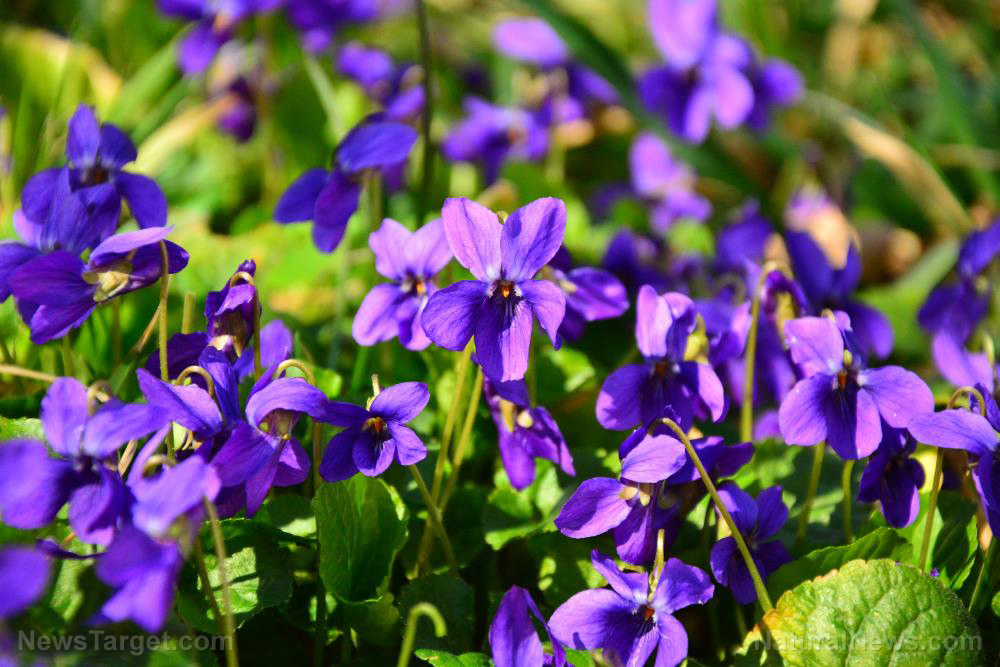
Wild violets bear beautiful flowers, but some people think of the plant as an annoyance that can take over a well-manicured lawn. But did you know that the wild violets, also called common blue violets, can be used to make natural remedies to boost your immunity? (h/t to TheSurvivalMom.com)
Differentiating wild violets and African violets
Wild violets (Viola sororia) are different from African violets (Saintpaulia ionantha). One main difference is that the latter is mostly grown as ornamental houseplants and they aren't edible.
Wild violets bear purple flowers and heart-shaped leaves, but they can also come in various shades of purple or white. Wild violets grow in clumps. The plant usually reaches at least four to six inches in height, but they can occasionally grow a bit taller.
Wild violets can be found in Zones 3 through 9 and they grow in areas of partial shade. A clump of wild violets can be transplanted to a garden. Take note that wild violets tend to spread if you don't place them in individual containers.
The many uses of wild violets
Here are 10 survival uses of wild violets:
- Wild violet petals or leaves can be added to salads or used as an ingredient in sandwiches.
- Wild violets can be used as edible decorations for desserts.
- Wild violets are full of vitamins A and C, among other nutrients.
- You can use wild violet flowers to make jelly, syrup, tea, and vinegar. The flowers can also be used to make candied violets.
- Wild violet tea is a natural remedy for insomnia.
- Wild violets can eliminate waste by stimulating the lymphatic glands of your body. This gets rid of toxins.
- Wild violets can boost your immune system and reduce inflammation. Drink wild violet tea to relieve colds, sinus infections, sore throats, and other respiratory conditions. (Related: Wild violets are useful plants that can help the smart prepper survive.)
- A poultice made from wild violets can treat headaches. It is believed that the salicylic acid in the flowers, an ingredient also found in aspirin, is responsible for this benefit.
- Wild violets have antiseptic properties and they can be used to make ointments or salves for minor scrapes and bruises.
- Wild violets can function as a mild laxative.
Tips for harvesting wild violets
Wild violets can often be harvested from May to June in most areas. Gather the flowers and use the petals fresh. Alternatively, you can dry some violet flowers for use throughout the year.
Make sure you only harvest wild violets from areas that aren't sprayed with any pesticides. It is best to harvest them in the morning when the blossoms are fresh and perky.
Making wild violet tea
Ingredients:
- 2 teaspoons of dried wild violet leaves
- 1 teaspoon of dried flowers or 2-3 teaspoons of fresh flowers
- 1 cup of boiling water
- Honey (optional)
Steps:
- Add the dried leaves and flowers to the cup of boiling water. Let the mixture steep for five minutes. Use fresh wild violets for a milder tasting tea.
- Strain the flowers and leaves before drinking.
- Add a bit of honey to boost the health benefits of the tea.
Making violet leaf and honey cough syrup
The basic syrup formula is one part violet leaf decoction to two or three parts honey.
Ingredients:
- Fresh or dried violet leaves
- Water
- Raw honey
Steps:
- Place the fresh or dried violet leaves in a jar. Fill the jar about 1/3 full.
- Pour cold water over the leaves, then put the jar in the fridge. Let it soak overnight.
- In the morning, simmer the mixture for 15 minutes.
- Strain the liquid from the leaves. You'll be left with a strong green-tinged decoction.
- Measure out a small amount of the wild violet decoction in a pan, then stir in twice as much honey.
- Over very low heat, gently stir the honey and decoction until they are fully incorporated. Don't let the mixture simmer or boil. Keep the heat under 110 F so you don't destroy the benefits of the raw honey.
- Let the mixture cool.
- Pour the mixture into a sterilized jar and close the lid tightly. Keep the syrup in your refrigerator.
The wild violet and honey cough syrup has a shelf life of about a month. Add several tablespoons of vodka, brandy, or an herbal tincture to make the syrup last longer. Label the syrup properly.
To use the syrup, give one to two teaspoons to children and one tablespoon for adults at least five times per day, until their cough is cured.
Interested in other natural cures that you can grow right in your garden? Visit SurvivalMedicine.news to learn more.
Sources include:
Please contact us for more information.





















